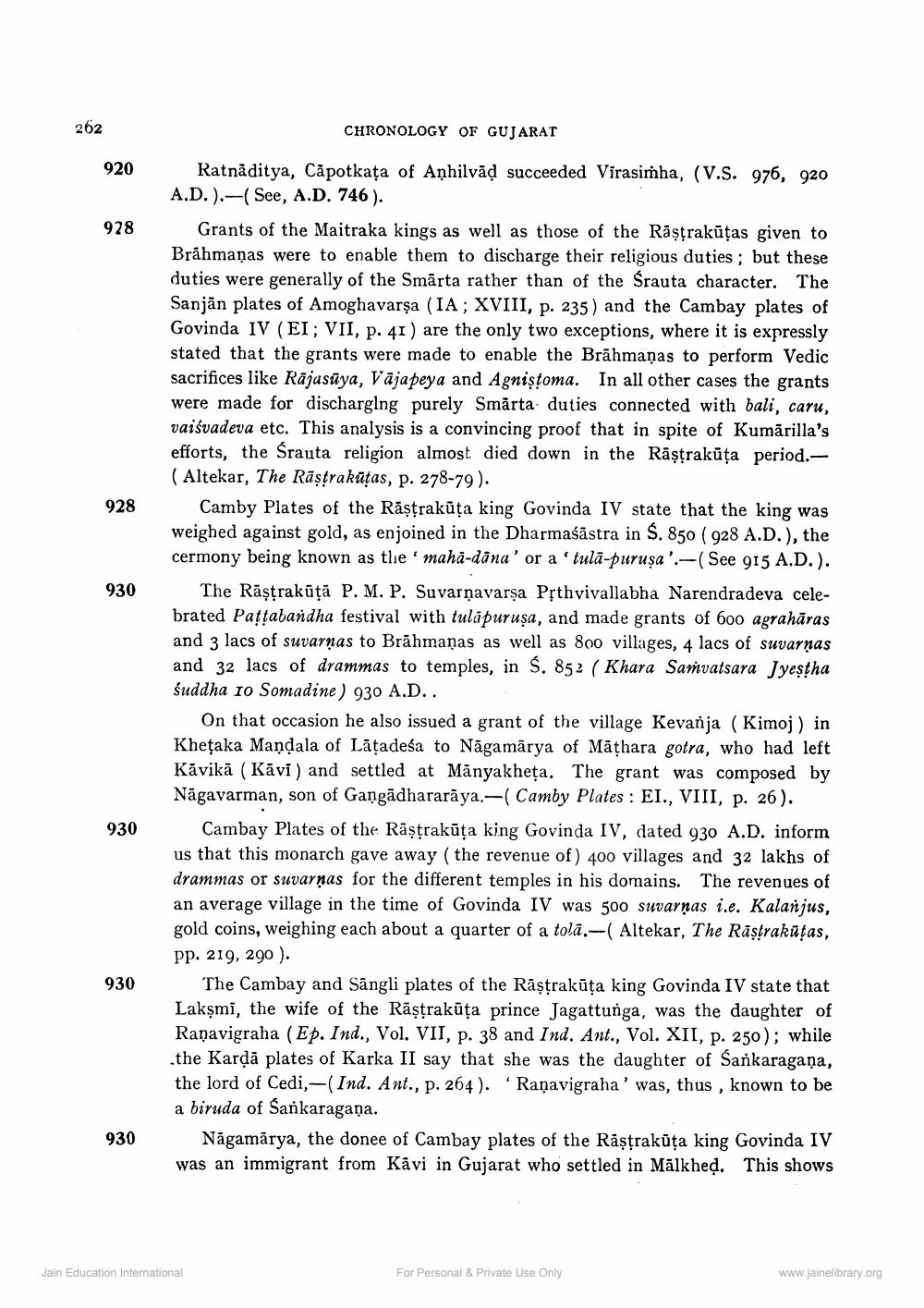________________
262
920
928
928
930
930
930
930
CHRONOLOGY OF GUJARAT
Ratnaditya, Capotkața of Anhilvaḍ succeeded Virasimha, (V.S. 976, 920 A.D.). (See, A.D. 746).
Grants of the Maitraka kings as well as those of the Rastrakütas given to Brahmanas were to enable them to discharge their religious duties; but these duties were generally of the Smarta rather than of the Śrauta character. The Sanjan plates of Amoghavarsa (IA; XVIII, p. 235) and the Cambay plates of Govinda IV (EI; VII, p. 41) are the only two exceptions, where it is expressly stated that the grants were made to enable the Brahmanas to perform Vedic sacrifices like Rajasaya, Vajapeya and Agnistoma. In all other cases the grants were made for discharging purely Smärta duties connected with bali, caru, vaisvadeva etc. This analysis is a convincing proof that in spite of Kumārilla's efforts, the Śrauta religion almost died down in the Raṣṭrakuța period.(Altekar, The Räṣṭrakātas, p. 278-79).
Camby Plates of the Răştrakuta king Govinda IV state that the king was weighed against gold, as enjoined in the Dharmasastra in S. 850 (928 A.D.), the cermony being known as the maha-dana' or a 'tula-purusa'.-(See 915 A.D.).
The Răṣṭrakūtā P. M. P. Suvarnavarṣa Prthvivallabha Narendradeva celebrated Paffabandha festival with tulapuruşa, and made grants of 600 agraharas and 3 lacs of suvargas to Brahmanas as well as 800 villages, 4 lacs of suvarnas and 32 lacs of drammas to temples, in S. 852 (Khara Samvatsara Jyestha Suddha 10 Somadine) 930 A.D..
On that occasion he also issued a grant of the village Kevanja (Kimoj) in Kheṭaka Mandala of Laṭadeśa to Nagamarya of Maṭhara gotra, who had left Kävikä (Kavi) and settled at Manyakheta. The grant was composed by Nagavarman, son of Gangadhararaya.-( Camby Plates: EI., VIII, p. 26).
Cambay Plates of the Rastrakāta king Govinda IV, dated 930 A.D. inform us that this monarch gave away (the revenue of) 400 villages and 32 lakhs of drammas or suvarnas for the different temples in his domains. The revenues of an average village in the time of Govinda IV was 500 suvarnas ie. Kalanjus, gold coins, weighing each about a quarter of a tola,-( Altekar, The Rastraktas, pp. 219, 290).
The Cambay and Sangli plates of the Raṣṭrakūta king Govinda IV state that Laksmi, the wife of the Räṣṭrakūta prince Jagattunga, was the daughter of Ranavigraha (Ep. Ind., Vol. VII, p. 38 and Ind. Ant., Vol. XII, p. 250); while .the Kardā plates of Karka II say that she was the daughter of Sankaragana, the lord of Cedi,-(Ind. Ant., p. 264). Rapavigraha' was, thus, known to be a biruda of Sankaragana.
Nagamarya, the donee of Cambay plates of the Räṣṭrakūta king Govinda IV was an immigrant from Kāvi in Gujarat who settled in Mälkhed. This shows
Jain Education International
For Personal & Private Use Only
www.jainelibrary.org




